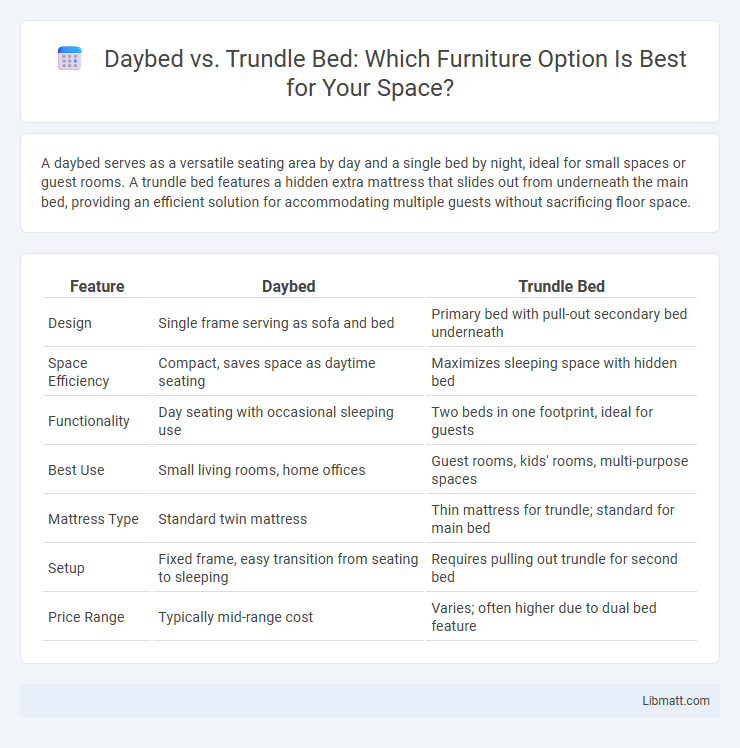A daybed serves as a versatile seating area by day and a single bed by night, ideal for small spaces or guest rooms. A trundle bed features a hidden extra mattress that slides out from underneath the main bed, providing an efficient solution for accommodating multiple guests without sacrificing floor space.
Table of Comparison
| Feature | Daybed | Trundle Bed |
|---|---|---|
| Design | Single frame serving as sofa and bed | Primary bed with pull-out secondary bed underneath |
| Space Efficiency | Compact, saves space as daytime seating | Maximizes sleeping space with hidden bed |
| Functionality | Day seating with occasional sleeping use | Two beds in one footprint, ideal for guests |
| Best Use | Small living rooms, home offices | Guest rooms, kids' rooms, multi-purpose spaces |
| Mattress Type | Standard twin mattress | Thin mattress for trundle; standard for main bed |
| Setup | Fixed frame, easy transition from seating to sleeping | Requires pulling out trundle for second bed |
| Price Range | Typically mid-range cost | Varies; often higher due to dual bed feature |
Introduction: Daybed vs Trundle Bed
A daybed combines the functionality of a sofa and a bed, making it an ideal choice for small spaces and dual-purpose rooms, while a trundle bed features a hidden secondary mattress that can be pulled out for additional sleeping capacity. Daybeds often include a backrest and sides, providing comfortable seating during the day, whereas trundle beds prioritize optimizing floor space with a compact design. Choosing between a daybed and a trundle bed depends on the need for seating versatility versus maximizing sleeping arrangements.
What is a Daybed?
A daybed is a versatile piece of furniture that functions as both a sofa and a bed, featuring a twin-sized mattress with a backrest and often incorporates a frame made of wood or metal. Designed primarily for seating during the day, it converts into a sleeping space at night, making it ideal for small spaces or guest rooms. Unlike trundle beds, daybeds do not include a secondary pull-out mattress underneath, emphasizing their dual-purpose design for lounging and sleeping.
What is a Trundle Bed?
A trundle bed is a low-profile bed stored underneath a main bed frame, designed to slide out and provide an extra sleeping surface when needed. It maximizes space efficiency, making it ideal for small rooms or guest accommodations. Unlike daybeds, trundle beds prioritize functionality and compact storage without doubling as seating furniture.
Key Differences Between Daybeds and Trundle Beds
Daybeds feature a single elevated frame that functions as both a sofa and a bed, making them ideal for versatile seating and sleeping in limited spaces. Trundle beds consist of a main bed frame with a hidden, pull-out mattress underneath, allowing you to accommodate an extra guest without sacrificing floor space. Your choice depends on whether you prioritize multifunctional furniture or maximizing sleeping capacity in a compact environment.
Space-Saving Benefits
Daybeds and trundle beds both offer excellent space-saving benefits by combining seating and sleeping options in one piece of furniture. A daybed serves as a sofa by day and a bed by night, ideal for small rooms or home offices, while a trundle bed features a hidden pull-out bed tucked underneath the main frame, perfect for accommodating overnight guests without sacrificing floor space. Your choice depends on whether you prioritize everyday seating or maximizing sleeping capacity in limited spaces.
Comfort and Mattress Options
Daybeds typically feature twin-size mattresses designed for seating comfort and occasional sleeping, offering a firm surface ideal for back support. Trundle beds include a secondary mattress stored beneath the main bed, often thinner but suitable for children or short-term use, allowing for flexible sleeping arrangements. Mattress options for daybeds range from memory foam to innerspring, while trundle mattresses prioritize compactness and easy storage, often available in foam or lightweight coil designs.
Design and Style Comparison
Daybeds feature a versatile design that blends the elements of a bench and a sofa with a twin-sized mattress, often showcasing sleek frames and open sides for a stylish, space-saving appeal. Trundle beds incorporate a secondary bed stored underneath the main frame, typically hidden on wheels, providing an efficient solution for accommodating guests without compromising on room aesthetics. While daybeds emphasize a casual, lounge-like style suitable for living rooms or multi-purpose spaces, trundle beds prioritize practical functionality with a minimalist design ideal for bedrooms or guest rooms.
Cost Analysis: Daybed vs Trundle Bed
Daybeds generally cost less than trundle beds due to their simpler design and fewer components. Trundle beds include an additional pull-out mattress frame, increasing both material and manufacturing costs, which can raise the overall price by 20-40%. Your budget may stretch further with a daybed if you prioritize affordability without the need for extra sleeping space.
Best Uses and Ideal Rooms
Daybeds are best suited for small living rooms, guest rooms, or home offices where they function as seating by day and a bed by night, providing a versatile solution for limited spaces. Trundle beds excel in children's bedrooms or guest rooms where maximizing sleeping capacity is essential, as they offer a hidden secondary mattress that can be easily pulled out when needed. Both options optimize space effectively, with daybeds enhancing multi-functionality and trundle beds providing accommodation for multiple sleepers without compromising floor area.
Which Is Right for You?
A daybed offers versatility as a seating area by day and a sleeping space by night, ideal for small living rooms or guest rooms needing dual functionality. A trundle bed provides an extra hidden bed that easily pulls out, perfect for accommodating overnight guests without sacrificing floor space. Your choice depends on whether you prioritize multifunctional furniture or maximized sleeping capacity in compact areas.
Daybed vs Trundle Bed Infographic

 libmatt.com
libmatt.com